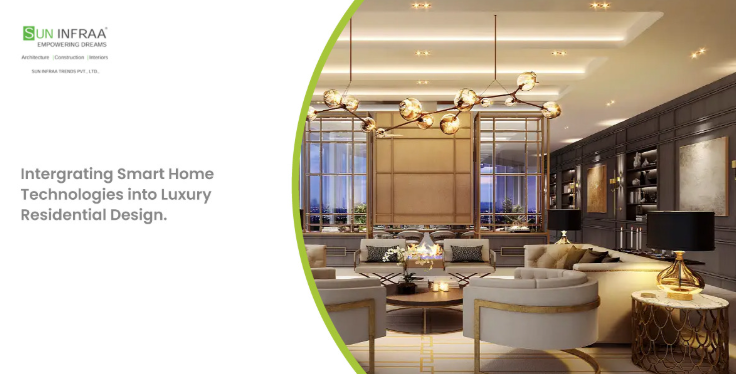Integrating Smart Home Technologies into Luxury Residential Design
The concept of luxury in residential design has evolved beyond opulent materials and grand architecture. Today, true luxury is defined by convenience, comfort, and cutting-edge technology. Smart home technologies are revolutionizing modern living, seamlessly blending innovation with sophisticated aesthetics. Whether you are designing a new home or upgrading an existing one, integrating smart technology into the residential interior segment enhances both functionality and style.
Here’s a look at how smart home technologies can elevate luxury residential design.
1. Smart Lighting for Ambiance & Efficiency
Lighting plays a crucial role in setting the mood and enhancing the overall aesthetic of a luxury home. With smart lighting systems, homeowners can control brightness, color temperature, and ambiance with a simple voice command or mobile app.
Key Features:
- Automated Scheduling: Lights adjust based on time of day, enhancing comfort and energy efficiency.
- Mood-Based Settings: Pre-set lighting scenes for dining, relaxation, or entertainment.
- Motion Sensors: Lights turn on or off automatically, adding convenience and security.
Design Tip: Hidden LED strip lights or chandeliers integrated with smart dimming features add both luxury and functionality.
2. Intelligent Climate Control for Ultimate Comfort
Maintaining the perfect temperature is essential in luxury homes. Smart thermostats and HVAC systems adapt to homeowners’ preferences, creating an energy-efficient yet comfortable environment.
Key Features:
- AI-Based Learning: Devices like Nest and Ecobee analyze user habits and adjust temperature settings automatically.
- Zoned Heating & Cooling: Different rooms can have individual temperature settings for personalized comfort.
- Remote Control: Homeowners can adjust the climate from anywhere via smartphone apps.
Design Tip: Integrating climate control into sleek, wall-mounted panels or voice assistants ensures seamless design flow.
3. Automated Window Treatments for Style & Privacy
Luxury interior design often includes floor-to-ceiling windows that offer breathtaking views. However, managing natural light and privacy requires smart solutions.
Key Features:
- Motorized Blinds & Curtains: Open or close with voice commands or scheduled automation.
- Sunlight Sensors: Adjust shades based on the intensity of natural light, reducing glare and heat.
- Integration with Smart Lighting: Sync window treatments with lighting for a harmonious ambiance.
Design Tip: Choose high-end fabrics and materials for motorized curtains to complement the aesthetics of your residential interior segment.
4. Smart Security for Peace of Mind
A true luxury home is not just beautiful—it is also safe. Smart security systems provide homeowners with real-time monitoring and control over their property.
Key Features:
- Biometric Door Locks: Use fingerprint or facial recognition for secure, keyless entry.
- AI-Powered Surveillance Cameras: Detect unusual activity and send instant alerts.
- Smart Video Doorbells: Allow homeowners to see and communicate with visitors remotely.
Design Tip: Conceal security cameras within elegant décor elements for a seamless, unobtrusive look.
5. Home Automation Hubs for Seamless Control
Luxury living should be effortless. A centralized home automation system allows homeowners to control lighting, climate, security, and entertainment from a single interface.
Key Features:
- Voice Control Compatibility: Works with Alexa, Google Assistant, and Apple HomeKit.
- Customizable Dashboards: Personalized controls for different areas of the home.
- Multi-Room Synchronization: Devices work together for a cohesive smart home experience.
Design Tip: Install discreet, wall-mounted control panels that blend with the home’s interior aesthetics.
Conclusion
Integrating smart home technologies into the residential interior segment is not just about convenience—it’s about redefining luxury living. From automated lighting to AI-powered security and intelligent climate control, smart technology seamlessly enhances both aesthetics and functionality. When thoughtfully designed, a luxury smart home offers an effortless, elegant, and immersive living experience.



